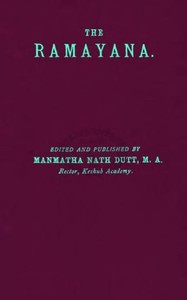| Summary |
"The Rāmāyana, Volume 4. Uttara Kānda" by Valmiki is an epic poem from ancient Indian literature, composed during a time period that can be estimated to be between the 5th century BCE and the 4th century CE. This significant text forms part of the larger Rāmāyana epic, which tells the story of Lord Rama, a prince of Ayodhya, his wife Sita, and his loyal companion Lakshmana. In this volume, the narrative primarily centers around themes of dharma (duty/righteousness), heroism, and the complex dynamics of good and evil, as experienced through the characters' interactions and challenges, particularly focusing on the aftermath of Ram's conflict with Ravana. The opening of this volume introduces the aftermath of significant events, including the slaying of the Rākshasas. Various ascetics come to praise Rama for regaining his kingdom, emphasizing his might and the righteousness of his actions. During these interactions, the text delves into a conversation about the powerful foes defeated by Rama, especially the Rākshasa Indrajit, and questions arise regarding how Indrajit managed to achieve such prowess. As Rama expresses curiosity about these events and the lineage of the Rākshasas, the sage Agastya begins to recount the origins of the Rākshasa lineage, discussing their progenitors and the historical background of their antagonism against the celestial beings. This opening sets the stage for conflicts that explore the themes of divine intervention, destiny, and the battle between good and evil that pervades the Rāmāyana. (This is an automatically generated summary.)
|

